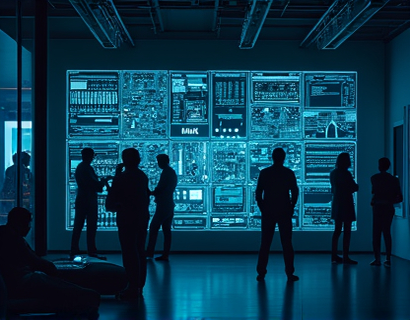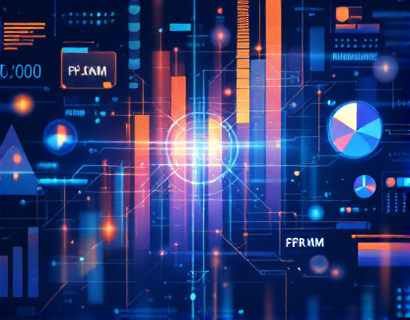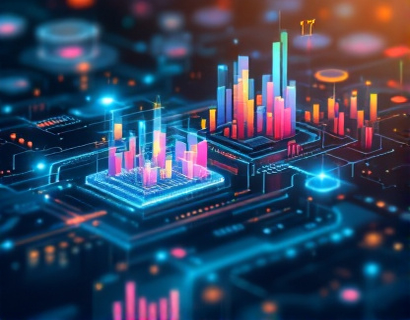Revolutionizing Digital Engagement: The Synergy of Crypto and AI in Next-Gen Ucosystem Solutions
The intersection of blockchain technology and artificial intelligence (AI) is giving rise to transformative solutions that are redefining user engagement in the digital space. This article delves into the profound impact of integrating these advanced technologies, exploring how they are enhancing user experiences and driving growth within the tech ecosystem. By examining the synergy between blockchain and AI, we can uncover the innovative approaches that are reshaping interactions and unlocking new opportunities for tech enthusiasts and early adopters.
Understanding the Basics: Blockchain and AI
To fully appreciate the transformative potential of combining blockchain and AI, it's essential to first understand the fundamental principles of each technology. Blockchain, at its core, is a decentralized ledger that records transactions across multiple computers in such a way that the registered transactions cannot be altered retroactively. This technology ensures transparency, security, and immutability, making it ideal for applications requiring trust and verification.
Artificial intelligence, on the other hand, encompasses a range of technologies designed to simulate human intelligence processes by machines, particularly computer systems. These processes include learning (the acquisition of information and rules for using it), reasoning (using rules to reach approximate or definite conclusions), and self-correction. AI's capabilities span from simple data analysis to complex decision-making, enabling systems to adapt and improve over time.
The Synergy of Blockchain and AI
The true power of integrating blockchain and AI emerges when these technologies are combined to create solutions that leverage the strengths of both. Blockchain provides a secure and transparent framework, while AI brings intelligence and adaptability. Together, they can enhance user engagement by creating more secure, personalized, and efficient interactions within digital ecosystems.
One of the primary ways this synergy manifests is through decentralized applications (dApps). dApps built on blockchain platforms can utilize AI to offer dynamic and responsive user experiences. For instance, AI algorithms can analyze user behavior and preferences to tailor content and services, ensuring that each user receives a customized experience. This level of personalization not only increases user satisfaction but also fosters deeper engagement with the platform.
Enhancing Security and Trust
Security is a paramount concern in the digital world, and the combination of blockchain and AI addresses this issue effectively. Blockchain's inherent security features, such as cryptographic hashing and consensus mechanisms, ensure that data is tamper-proof and transparent. AI, with its advanced analytics and pattern recognition capabilities, can detect and mitigate potential security threats in real-time.
For example, AI-driven security systems can monitor blockchain networks for unusual activities that may indicate a breach or fraudulent behavior. By analyzing vast amounts of data, AI can identify anomalies and trigger alerts, allowing for swift action to be taken. This proactive approach to security enhances user trust and confidence in the platform, which is crucial for sustained engagement.
Personalization and User Experience
Personalization is a key driver of user engagement, and the integration of AI in blockchain-based systems takes this to new heights. AI algorithms can process and analyze user data to create highly personalized experiences. In the context of blockchain, this means that users can enjoy tailored services and content without compromising their privacy or security.
Consider a scenario where a user interacts with a blockchain-based marketplace. AI can analyze the user's past transactions, preferences, and behavior to recommend products or services that align with their interests. This level of personalization not only enhances the user experience but also increases the likelihood of repeat interactions and higher user retention rates.
Decentralized Identity Management
Another significant area where blockchain and AI converge is in decentralized identity management. Traditional identity verification processes are often centralized, vulnerable to breaches, and can be cumbersome for users. By leveraging blockchain, identities can be stored securely and managed decentralized, while AI can streamline the verification process.
AI-powered identity verification systems can use biometric data, behavioral patterns, and other factors to authenticate users in a seamless and secure manner. This not only enhances security but also simplifies the user experience, reducing friction and increasing engagement. Users can control their identity data and share it selectively, maintaining privacy while enjoying a smooth and trustworthy interaction.
Smart Contracts and AI-Driven Automation
Smart contracts, self-executing contracts with the terms directly written into code, are a cornerstone of blockchain technology. When combined with AI, smart contracts can become even more powerful and efficient. AI can automate the execution of smart contracts based on real-time data and conditions, ensuring that agreements are fulfilled accurately and promptly.
For instance, in supply chain management, AI can monitor various parameters such as temperature, location, and status of goods. Smart contracts can then automatically trigger actions, such as payments or alerts, based on these conditions. This level of automation not only improves efficiency but also reduces the risk of human error, leading to higher user satisfaction and trust in the system.
Data Privacy and User Control
Data privacy is a growing concern for users, and the combination of blockchain and AI offers robust solutions to address this issue. Blockchain's decentralized nature ensures that data is not stored in a single point of failure, reducing the risk of large-scale breaches. AI can further enhance privacy by enabling users to have more control over their data.
AI-driven tools can help users manage and monetize their data, allowing them to decide who can access their information and for what purposes. Blockchain ensures that these transactions are transparent and secure, providing users with peace of mind. This empowerment of users not only enhances trust but also fosters a more engaged and loyal user base.
Challenges and Considerations
While the integration of blockchain and AI presents numerous opportunities, it also comes with challenges that need to be addressed. One of the primary concerns is the computational complexity and resource requirements of AI algorithms, especially when deployed on blockchain networks. Ensuring scalability and efficiency is crucial to maintain performance and user satisfaction.
Another consideration is the regulatory landscape. As these technologies evolve, regulatory frameworks are still catching up. Compliance with data protection laws, such as GDPR, is essential to ensure that user data is handled responsibly. Developers and organizations must stay informed and adapt to these regulations to maintain user trust and avoid legal issues.
Future Prospects and Innovations
The future of blockchain and AI integration holds immense potential for further innovations in user engagement. As technology advances, we can expect more sophisticated AI models that can operate more efficiently on blockchain networks. This could lead to even more personalized and seamless user experiences.
Additionally, the rise of Web3 and decentralized applications is paving the way for a new internet paradigm where users have more control and ownership of their data. Blockchain and AI will play pivotal roles in shaping this future, creating ecosystems that are not only more secure and efficient but also more user-centric.
In conclusion, the synergy between blockchain and AI is revolutionizing digital engagement by enhancing security, personalization, and efficiency. As these technologies continue to evolve, they will unlock new opportunities for tech enthusiasts and early adopters, driving growth and innovation in the tech ecosystem. By embracing this synergy, we can create a more resilient, transparent, and user-friendly digital world.










































